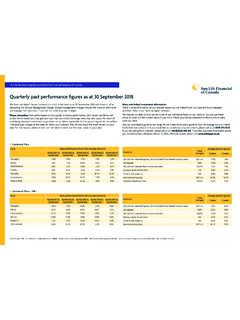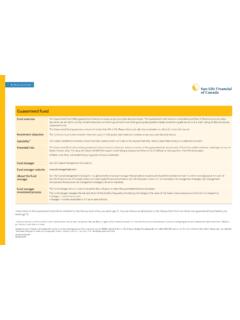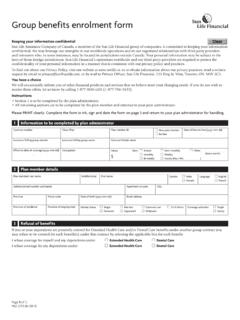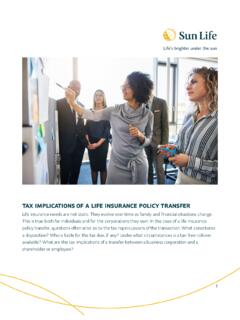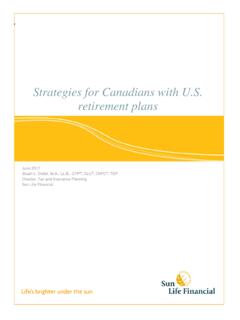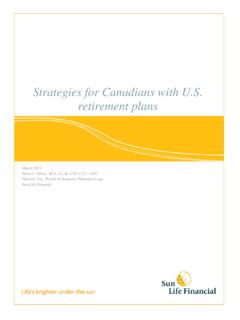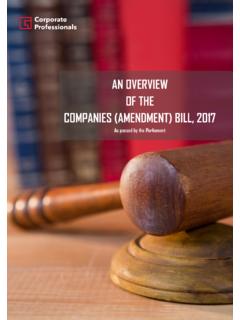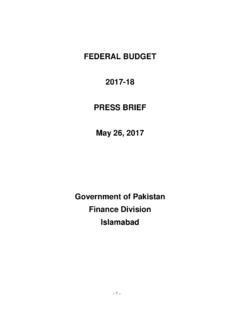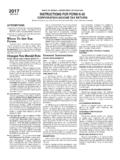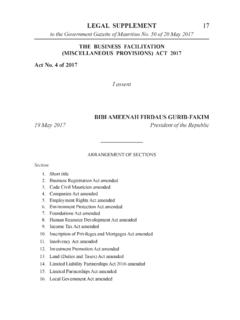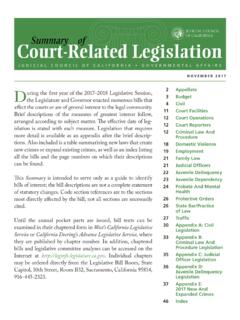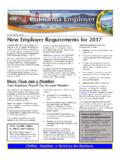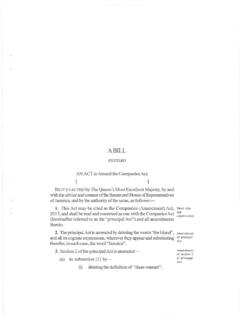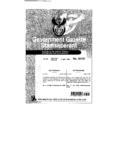Transcription of ADVISOR USE ONLY Impact of 2017 tax changes on THE …
1 1 ADVISOR USE ONLY Life s brighter under the sun Impact of 2017 tax changes on life insurance THE DETAILS Life insurance provides protection, but some policies also allow clients to accumulate savings on a tax-preferred basis. The Income Tax Act governs how much growth can accumulate within a life insurance policy, contains rules on how those savings are valued, and the tax implications associated with accessing them. The exempt test is used to distinguish between a life insurance policy that s primarily: focused on protection an exempt policy, which receives tax-preferred treatment, or an investment accumulation vehicle a non-exempt policy, with investment growth taxed annually.
2 The exempt test compares the savings component of the actual life insurance policy to the savings component of a theoretical benchmark policy (the exempt test policy or ETP). This article takes a closer look at how tax changes will affect life insurance policies issued as of January 1, 2017 . There haven t been many changes since the current Income Tax Act provisions related to life insurance were put in place in 1982. But since then, product development and innovation has led to the potential for inconsistent treatment of different product types. In particular, Universal Life (UL) insurance wasn t fully considered when the existing rules were written. The new rules take the unique attributes of UL into account.
3 In the 2012 federal budget, the Department of Finance indicated it would introduce legislation to modernize the life insurance exempt test and related rules. After consultation with the industry and interested players, Bill C-43 received Royal Assent on December 16, 2014. An implementation period was provided, with the rules going into effect January 1, 2017 . Grandfathering rules will be in place for policies issued prior to that date. THE KEY changes INCLUDE:1 1 Bill C-43 also included changes that Impact the taxation of prescribed annuity contracts. This article is limited to changes specific to life insurance policies. a revised definition of the benchmark policy, prescribed assumptions when calculating the savings element, known as the Accumulating Fund (AF) of the exempt test policy, prescribed assumptions and changes to the reserve method when calculating the AF of the actual policy, revisions to the 8% rule and the 250% test, updated mortality tables for calculating the Net Cost of Pure Insurance (NCPI), and changes to the formula for the Adjusted Cost Basis (ACB) of a life insurance policy.
4 While changes are needed to accommodate these new rules, all product types, including UL, will continue to provide clients with tax-preferred protection and savings solutions. The following provides a review of the changes . Acronyms ACB Adjusted Cost Basis AFAccumulating Fund CDA Capital Dividend Account CIA Canadian Institute of Actuaries COI Cost of Insurance GIO Guaranteed Insurability Option ETP Exempt Test Policy LCOI Level Cost of Insurance NCPI Net Cost of Pure Insurance NPR Net Premium Reserve2 THE EXEMPT TEST POLICYE very life insurance policy is compared to a hypothetical, benchmark policy called the exempt test policy (ETP), with the comparison against the actual policy occurring at each policy anniversary.
5 As long as the savings component of the actual policy stays within the savings element of the ETP, it will remain exempt. The ETP is currently based on a 20-pay endowment policy at age 85. This means that a policy that would pay a lump sum at age 85 if the insured was still living, based on 20 premium payments. With the new legislation, the ETP will be based on an 8-pay endowment policy at age 90. This change may provide additional funding room in a policy s early years, and a reduction in the later years. THE FOLLOWING GRAPH DEMONSTRATES THE changes . change in Exempt Test Line THE ACCUMULATING FUNDThe savings element of the ETP and the actual policy is measured by the Accumulating Fund (AF) in each policy.
6 Historically, insurers used their own pricing or cash value assumptions in order to measure the AF of the ETP. The new legislation defines the assumptions used to calculate the AF for the ETP as follows: Interest rates will use a fixed assumption of Mortality will be based on the Canadian Institute of Actuaries (CIA) 1986-1992 table. Currently, the AF of the actual policy is equal to the higher of the cash value of the policy, or an actuarially calculated reserve known as the preliminary term reserve. For UL policies with variable premiums, the reserve component was not able to be determined, so insurers looked to the cash value of the policy to determine the AF instead. Surrender charges reduced the cash value allowing for a lower AF, and more deposit room available in the policy in the early years.
7 The new rules continue to have the AF of the actual policy as the higher of the cash value of the policy, or an actuarially calculated reserve. The new reserve method is called the Net Premium Reserve (NPR) and is based on the premium or cost of insurance pattern. The assumptions used to calculate the NPR for the AF for the actual policy are prescribed in the new rules. Instead of using pricing or cash value assumptions, the interest and mortality assumptions will be the same as those used to value the AF of the ETP. Surrender charges will no longer be taken into account when comparing against the cash value. This significantly impacts the AF of UL policies, particularly so for Level Cost of Insurance (LCOI) UL policies.
8 The changes to the AF of the actual policy when compared to the ETP change the pattern of the funding room, with the potential for a reduction over the lifetime of the policy. This will be particularly significant with LCOI UL, due to the change in the reserve calculations. The Impact to traditional types of insurance, such as participating insurance, will be much less severe. Level COI change in Funding Room800 change from 20 payMove fromto 8 85 to 90600 change in mortality 400and interest assumptions2002017 Exempt LineCurrent Exempt Line051015202530354045505560 Policy Years$1000$1000800600 New Current funding room400funding room200 ETP rateNPR - Level04550556065707580859095100105 Attained AgeLevel COI change in Funding Room0200400600800$1000 ETP rateNPR - Level1051009590858075706560555045 New funding roomCurrent funding roomAttained Age3 THE 8% RULETo help ensure the policy remains exempt, the death benefit can be increased by up to 8% annually.
9 Sometimes, a policy election can be made for this to happen automatically if it s in the policy owner s best interest to do so. When the death benefit of a policy increases by more than this amount, a new ETP is established. This new ETP for the additional insurance amount is issued at the current date. This limits the amount of exempt room when compared against increasing the original ETP for the entire amount. The 8% rule is currently applied at a policy level looking at the entire death benefit amount under a particular policy. If any of the following apply, the 8% increase can be allocated to whichever coverage is necessary in order to maintain exempt status and avoid issuing a new ETP.
10 Multiple lives are insured under the policy There s a term rider A UL policy is designed to pay the face value plus a fund value The rule will remain in 2017 , but instead of using 8% of the full death benefit, it will apply at a life coverage level. If there are multiple lives under 1 policy, the 8% increase can only be applied in respect to each particular life. If a policy pays the face plus the fund value at death, the fund value will be treated separately from the face value for the purposes of the 8% test. It s expected that this change will reduce the amount of exempt room available within certain policies. THE 250% TEST The 250% test (also known as the anti-dump-in rule) was established to prevent policy owners from underfunding a policy in the early years to accumulate additional deposit room that could be used in the future.
